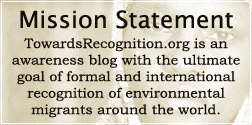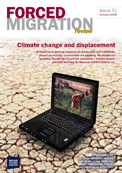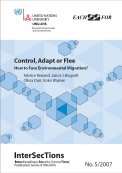Robert McLeman of the University of Ottawa and International Organization for Migration released a report entitled “Climate Change, Migration, and International Security Considerations.”
Executive Summary
The impacts of anthropogenic climate change are expected to lead to large-scale population displacements and migrations in the coming decades, with the potential to create instability and conflict in the most vulnerable regions. An oft-cited prediction by Myers (2002) suggests that climate change and other environmental factors could lead to 200 million people being displaced by mid-century; other estimates suggest that as many
as 1 billion people could be displaced. Such estimates are not based on statistical or empirical evidence, and it is arguable whether any population movements presently being observed are attributable to climatic change.
That said, climate-related conditions and events can and do stimulate population displacements and migrations. Scholars see migration as one of the many possible ways by which people adapt to the climate. Anthropogenic climate change is expected to increase the frequency and/or magnitude of many climatic events and conditions known to stimulate migration, with sea level rise posing new risks to coastal settlements and small island states. The first migration movements in the coming years that will be clearly attributable to climate change are likely to be movements of opportunity-seeking economic migrants into Northern regions as sea and land ice disappears.
Over the longer term, the greatest volume of climate change-related migration is likely to emerge in dryland and coastal regions that are highly exposed to the emergent physical impacts of climate change and where population growth rates are high. Where such conditions coincide in developing regions, there will be a heightened potential for conflict, violence and distress migration due to increased scarcity of critical resources or increased valuation of geographically concentrated resources. However, in most instances, there will be many opportunities for prevention and
intervention before violence emerges.
Avoiding large-scale climate-related population displacements and migrations in the future will require concerted international effort to mitigate greenhouse gas (GHG) emissions and build adaptive capacity in the most vulnerable regions. Limited progress is presently being made in international negotiations on either front; in the meantime, global GHG emissions continue to rise and access to critical food and water resources is becoming increasingly precarious in many developing regions. Unless current trends change, population displacements and migrations seem inevitable and are likely to emerge within the next 20 years. The largest movements will occur internally within vulnerable countries and regions, although there will be increased international migration as well, especially along established migration routes and networks. Current international law with respect to migration does not account for those displaced across international borders for climate-related reasons, presenting an additional future challenge for the international community.
In the worst-case scenario, the impacts of climate change will cause large-scale population displacements in unstable states such as Pakistan, reverse a decade of peace-building progress in West Africa, create new diasporas from small island states, and cause already-crowded urban centres to swell with additional impoverished rural migrants.
Read the full report here.



